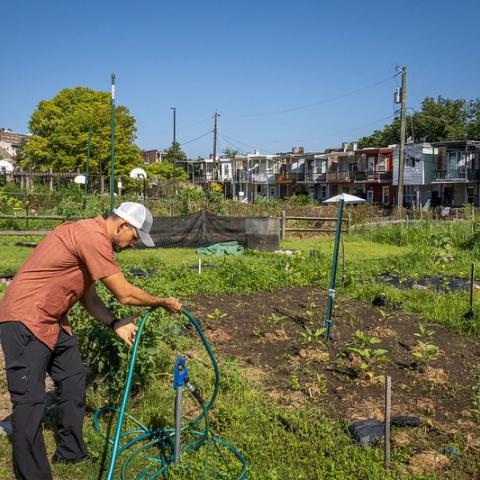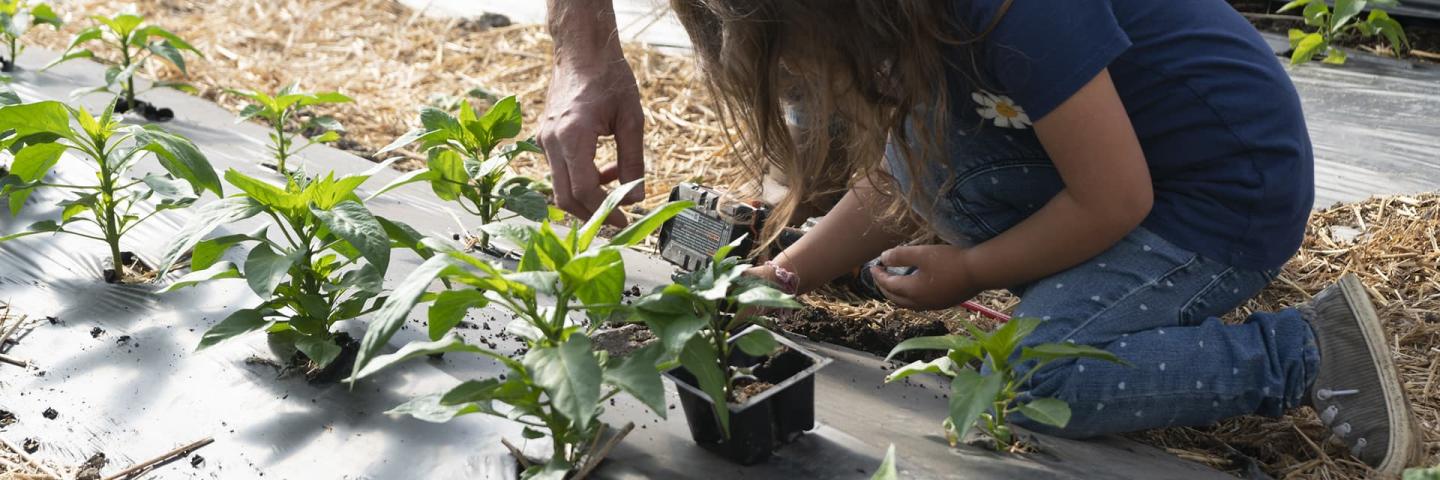
News

Community Agriculture is an Environmental Quality Incentives Program (EQIP) initiative used by NRCS in Montana.
NRCS Montana has developed the Montana Urban Agriculture - A Community Agriculture Strategic Plan. This plan outlines in broad strokes our definition of community agriculture and our plans to further NRCS support of community ag operations, partners, and education.
Urban agriculture is not a phrase that resonates in Montana, a primarily rural state. We are electing to use community agriculture in its place.
Community agriculture producers can be any size. They provide food, fiber, and other resources to Montana's communities in many ways - from produce, grains, honey, and proteins to jobs, open space, and natural resource management.
NRCS Montana provides technical and financial assistance to growers with:
Soil Health- As experts in soil health, NRCS can advise producers on things like how, when, and what cover crops to grow; diverse crop rotations; evaluating soil conditions; identifying soil health testing needs; how to add soil organic matter and nutrients by mulching and composting; and low input management strategies.
Irrigation and Water Conservation- NRCS can help ag producers conserve water, by assisting with things like drip irrigation and irrigation water management.
Wildlife Habitat- NRCS can provide financial assistance for planting pollinator habitat for beneficial insects, adding structures to attract desired wildlife, and various other practices that will support a healthy ecosystem.
Season Extension- NRCS can provide financial assistance for both high tunnels and low tunnels, used to extend the growing season and to protect plants from harsh weather, air pollution, and pests. By making local and produce available for more months in the year, fewer resources are used to transport food to plates.
Eligible land includes land on which agriculture commodities, livestock, or forest related products are produced. Montana NRCS will use the following eligible land uses for the Community Agriculture Initiative:
See the Montana Payment Schedule below for practices. Detailed descriptions of these conservation practices can be found in the Field Office Technical Guide, Section 4 - Practice Standards and Supporting Documents. All practices are eligible except the following: 666 Forest Stand Improvement, 383 Fuel Break, 384 Woody Residue Treatment, 442 Sprinkler Systems (Center Pivot), 642 Water Wells (to provide irrigation water).
An expanded set of conservation practices tailored to the conservation needs of small-scale ag producers has been developed, but producers are not limited to these practices. For example, some payment rates are now based on square feet rather than acres of implementation for practices like grazing management, irrigation water management, pest management, and cover crops. In addition, some new practices have been added including low tunnel management and compost or compost plus biochar in small areas. Ask your local NRCS conservationist for more information about these small-scale ag practices.
There is no limit to the size of a high tunnel or number of high tunnels for which a producer can apply. However, a maximum practice payment cap per high tunnel has been established.
For a high tunnel to be eligible for possible funding it must be on land that is currently producing direct to consumer (human) products. Production is defined as: the soil has been prepared and crop(s) have been planted and tended to through the growing season.
A high tunnel is defined as: a structure that meets our standards and specifications found in the Montana Field Office Technical Guide (FOTG) for CPS 325. The crop is grown in the natural soil profile, and heating/cooling/lighting is via passive methods (except for a simple fan). The following two practices will not be contracted as facilitating practices for high tunnels or as standalone practices for existing high tunnels. However, we do have guides available for customers interested in micro-irrigation in high tunnels.
All high tunnel systems will be planned, designed, and constructed from a manufactured kit, in accordance with the manufacturer’s recommendations. Upon completion, the high tunnel system will meet Montana CPS (325) High Tunnel Standards, Specifications, and Implementation Requirements.
This practice does not include greenhouses. NRCS does not provide financial assistance for
greenhouses. A greenhouse is defined as any structure not meeting the Standards and
Specifications as found in the Montana FOTG for CPS (325) High Tunnel.
Program applications are accepted on a continual basis. However, NRCS establishes application ranking dates for evaluation, ranking and approval of eligible applications. Applications received after the ranking date will be automatically deferred to the next funding period. See Montana Programs and Application Dates.
Applications must meet the intent of this initiative. For more details about this initiative, contact your local field office.
NRCS uses these questions to evaluate eligible applications for this project and to prioritize applications for potential funding.
The Environmental Quality Incentives Program (EQIP) provides financial and technical assistance to agricultural producers and non-industrial forest managers.
Learn MoreThe 2018 Farm Bill was enacted on December 20, 2018. The Farm Bill continues its strong support for conservation efforts of America’s farmers and ranchers through reauthorization and expanded flexibility of NRCS conservation programs.
Learn MoreContact your local service center to start your application.
Do you farm or ranch and want to make improvements to the land that you own or lease?
Natural Resources Conservation Service offers technical and financial assistance to help farmers, ranchers and forest landowners.

To get started with NRCS, we recommend you stop by your local NRCS field office. We’ll discuss your vision for your land.
NRCS provides landowners with free technical assistance, or advice, for their land. Common technical assistance includes: resource assessment, practice design and resource monitoring. Your conservation planner will help you determine if financial assistance is right for you.
We’ll walk you through the application process. To get started on applying for financial assistance, we’ll work with you:
Once complete, we’ll work with you on the application, or CPA 1200.
Applications for most programs are accepted on a continuous basis, but they’re considered for funding in different ranking periods. Be sure to ask your local NRCS district conservationist about the deadline for the ranking period to ensure you turn in your application in time.
As part of the application process, we’ll check to see if you are eligible. To do this, you’ll need to bring:
If you don’t have a farm number, you can get one from USDA’s Farm Service Agency. Typically, the local FSA office is located in the same building as the local NRCS office. You only need a farm number if you’re interested in financial assistance.
NRCS will take a look at the applications and rank them according to local resource concerns, the amount of conservation benefits the work will provide and the needs of applicants. View Application Ranking Dates by State.
If you’re selected, you can choose whether to sign the contract for the work to be done.
Once you sign the contract, you’ll be provided standards and specifications for completing the practice or practices, and then you will have a specified amount of time to implement. Once the work is implemented and inspected, you’ll be paid the rate of compensation for the work if it meets NRCS standards and specifications.